Impact Analysis of Survivability-Oriented Demand Response on Islanded Operation of Networked Microgrids with High Penetration of Renewables
Abstract
:1. Introduction
- In contrast to the existing literature, where DR is triggered by market price signals, DR is triggered by renewable power and load amount in this study. To the best of the author’s knowledge, this is the first study on local-resource triggered DR programs. The major advantages of the local-resource triggered DR program are as follows:
- ♦
- The proposed model doesn’t require any prior information of event occurrence and clearance times. Instead, the proposed model can be activated after detecting the event and can be deactivated after event clearance.
- ♦
- The proposed model maintains the linear tractability of the model and can be implemented using commercial optimization software tools like CPLEX, which guarantee the global optimality of the solution.
- ♦
- Each microgrid can adjust its local demand profile, thus eliminating the need for additional external DR Manager. Surplus or deficit in individual microgrids can be adjusted by sharing power among other microgrids of the network.
- The uncertainties in load and renewable output power are realized via a robust optimization method and the worst-case scenario is considered. In addition, three different scenarios (independent operation, interconnected operation without DR, and the proposed method) are realized and their performance is evaluated.
- Sensitivity analysis of renewable penetration level, amount of shiftable loads, and load absorption level in each microgrid is carried out to evaluate the performance of the proposed method under different conditions.
2. Microgrid Network and Survivability-Oriented Demand Response
2.1. Network Configuration
2.2. Demand Response for Survivability Enhancement
- Input Data: The first step is to read the input data of each microgrid. Input data is comprised of loads (AC, DC, and decomposition of each), renewables output power, component parameters, and penalty costs for load shedding and renewable curtailment. This information is transferred to the next step, where DR operation is carried out.
- DR Operation: The DR operation phase is further decomposed into three steps. In the first step, the ratio of critical and non-critical loads along with fixed and shiftable load ratios are analyzed. Then, the amount of renewable power is analyzed against the amount of load present in each microgrid, which was determined in the previous step. The load shifting is decided to maximize the utilization of renewables and minimize the load shedding amount. This will result in reshaping of the original load profiles. The reshaped load profiles of each microgrid are transferred to the next step, where the optimal operation of the microgrid network is carried out.
- Optimal Operation: In this step, the new load profiles from the previous step are utilized and the available resources are scheduled to minimize the load shedding amount. Load shedding of the whole network for the entire scheduling horizon is carried out in this step. In the islanded mode, service reliability is a major concern. Therefore, the relationship between penalties of load shedding and generation cost of CDGs, defined in the first step, plays an important role to assure the precedence of service reliability over operation cost in the emergency period.
3. Problem Formulation
3.1. Deterministic Model
3.1.1. Objective Function
3.1.2. Load Balancing Constraints
3.1.3. Constraints for Controllable Generators
3.1.4. Energy Trading Constraints
3.1.5. Battery Constraints
3.1.6. Demand Response Constraints
3.2. Uncertainty Modeling
3.2.1. Uncertain Variables and Uncertainty Bounds
3.2.2. Worst-Case Identification and Problem Transformation
3.2.3. Tractable Robust Load Balancing
3.3. Final Tractable Robust Counterpart
4. Numerical Simulations
4.1. Input Data
4.2. Impact of Interconnection and Demand Response on Survivability
4.2.1. Case 1: Independent Operation
4.2.2. Case 2: Interconnected Operation
4.2.3. Case 3: Interconnected with DR Operation
4.2.4. Performance Comparison
4.3. Discussion and Analysis
4.3.1. Shiftable Load Ratio
4.3.2. Renewable Penetration Level
4.3.3. Load Absorption Level
5. Conclusions
Author Contributions
Funding
Acknowledgments
Conflicts of Interest
Nomenclature
| Identifiers and Binary Variables | |
| Index of time, running from 1 to T. | |
| Index of microgrids, running from 1 to M and 1 to N, respectively. | |
| Index of dispatchable generators, running from 1 to G. | |
| Microgrid side identifier, A for AC side and D for DC side microgrid. | |
| Commitment status identifier of dispatchable generator g of X side MG m at t. | |
| Start-up and shut-down identifiers of dispatchable generator g of X side MG m at t. | |
| , | Identifier for charging and discharging of BESS in MG m at t. |
| Identifier for load shifting allowance in X side MG m from t’ to t. | |
| Variables and Constants | |
| Generation cost of dispatchable unit g of X side MG m at t. | |
| Amount of power generated by dispatchable unit g of X side MG m at t. | |
| Start-up cost of dispatchable unit g of X side MG m at t. | |
| Shut-down cost of dispatchable unit g of X side MG m at t. | |
| , | Penalty for shedding critical and non-critical loads in X side MG m at t. |
| , | Amount of critical and non-critical load shed in X side MG m at t. |
| Penalty and amount of renewable power curtailed in X side MG m at t. | |
| Amount of critical and non-critical load in X side MG m at t. | |
| Amount of adjusted load in X side MG m at t. | |
| Amount of load shifted from t’ to t in X side microgrid m. | |
| , | Amount of electrical energy charged/discharged to/from BESS of X side MG m at t. |
| , | Amount of power sent by/received from MG m at t. |
| Forecasted power of RDG unit of X side MG m at t. | |
| Capacity of line connecting mth MG with utility grid and nth MG, respectively. | |
| (t) | Amount of power received by mth MG from nth MG at t. |
| (t) | Amount of power sent by mth MG to nth MG at t. |
| , | Amount of power sent from AC to DC and DC to AC microgrid in MG m at t. |
| , | Capacity and efficiency of ILC connecting AC and DC microgrid in MG m at t. |
| Capacity and SOC of BEES in X side MG m at t. | |
| Charging and discharging loss of BESS in X side MG m. | |
| Initial amount of energy in BESS in X side MG m. | |
| , | Maximum load allowed to shift to and allowed to shift from t in X side MG m. |
| , | Amount of net critical load and shiftable load in X side MG m at t. |
| , | Bounded load and associated uncertainty bound in X side MG m at t. |
| Bounded RDG output power and associated uncertainty bound in X side MG m at t. | |
| , | Upper and lower bounds of load in X side MG m at t. |
| , | Upper and lower bounds of RDG output power in X side MG m at t. |
| Scaled deviations for load of X side MG m at t. | |
| Scaled deviations for WT power output of X side MG m at t. | |
| , | Budget of uncertainty and uncertainty adjustment factor of X side MG m at t. |
| , | Dual variables for load and RDG unit of X side MG m at t. |
References
- Khodaei, A. Resiliency-oriented microgrid optimal scheduling. IEEE Trans. Smart Grid 2014, 5, 1584–1591. [Google Scholar] [CrossRef]
- Hussain, A.; Bui, V.H.; Kim, H.M. A proactive and survivability-constrained operation strategy for enhancing resilience of microgrids using energy storage system. IEEE Access 2018, 6, 75495–75507. [Google Scholar] [CrossRef]
- Wang, Z.; Wang, J. Self-healing resilient distribution systems based on sectionalization into microgrids. IEEE Trans. Power Syst. 2015, 30, 3139–3149. [Google Scholar] [CrossRef]
- Hussain, A.; Bui, V.H.; Kim, H.M.; Im, Y.H.; Lee, J.Y. Optimal energy management of combined cooling, heat and power in different demand type buildings considering seasonal demand variations. Energies 2017, 10, 789. [Google Scholar] [CrossRef]
- Nguyen, D.T.; Le, L.B. Optimal energy management for cooperative microgrids with renewable energy resources. In Proceedings of the IEEE International Conference on Smart Grid Communications (SmartGridComm), Vancouver, BC, Canada, 21–24 October 2013. [Google Scholar] [CrossRef]
- Palensky, P.; Dietrich, D. Demand side management: Demand response, intelligent energy systems, and smart loads. IEEE Trans. Ind. Inform. 2011, 7, 381–388. [Google Scholar] [CrossRef]
- US DoE. Benefits of Demand Response in Electricity Markets and Recommendations for Achieving Them, Report to the US Congress. 2006. Available online: http://eetd.idi.gov (accessed on 19 December 2018).
- Silva, S.; Soares, I.; Pinho, C. Electricity demand response to price changes: The Portuguese case taking into account income differences. Energy Econ. 2017, 65, 335–342. [Google Scholar] [CrossRef]
- Samuel, O.; Javaid, S.; Javaid, N.; Ahmed, S.; Afzal, M.; Ishmanov, F. An efficient power scheduling in smart homes using Jaya based optimization with time-of-use and critical peak pricing schemes. Energies 2018, 11, 3155. [Google Scholar] [CrossRef]
- Carpinelli, G.; Mottola, F.; Proto, D. Optimal scheduling of a microgrid with demand response resources. IET Gen. Trans. Dist. 2014, 8, 1891–1899. [Google Scholar] [CrossRef]
- Imani, M.H.; Niknejad, P.; Barzegaran, M.R. The impact of customers’ participation level and various incentive values on implementing emergency demand response program in microgrid operation. Int. J. Electr. Power Energy Syst. 2018, 96, 114–125. [Google Scholar] [CrossRef]
- Hajibandeh, N.; Ehsan, M.; Soleymani, S.; Shafie-khah, M.; Catalão, J. The mutual impact of demand response programs and renewable energies: a survey. Energies 2017, 10, 1353. [Google Scholar] [CrossRef]
- Rezaei, N.; Kalantar, M. Stochastic frequency-security constrained energy and reserve management of an inverter interfaced islanded microgrid considering demand response programs. Int. J. Electr. Power Energy Syst. 2015, 69, 273–286. [Google Scholar] [CrossRef]
- Bayat, M.; Sheshyekani, K.; Hamzeh, M.; Rezazadeh, A. Coordination of distributed energy resources and demand response for voltage and frequency support of MV microgrids. IEEE Trans. Power Syst. 2016, 31, 1506–1516. [Google Scholar] [CrossRef]
- Gouveia, C.; Moreira, J.; Moreira, C.L.; Lopes, J.P. Coordinating storage and demand response for microgrid emergency operation. IEEE Trans. Smart Grid 2013, 4, 1898–1908. [Google Scholar] [CrossRef]
- Eshraghi, A.; Motalleb, M.; Reihani, E.; Ghorbani, R. Frequency regulation in Islanded microgrid using demand response. In Proceedings of the 2017 North American Power Symposium (NAPS), Morgantown, WV, USA, 17–19 September 2017. [Google Scholar]
- Wang, Y.; Pordanjani, I.R.; Xu, W. An event-driven demand response scheme for power system security enhancement. IEEE Trans. Smart Grid 2011, 2, 23–29. [Google Scholar] [CrossRef]
- Yang, X.; He, X.; Lin, J.; Yu, W.; Yang, Q. A novel microgrid based resilient demand response scheme in smart grid. In Proceedings of the 2016 17th IEEE/ACIS International Conference on Software Engineering, Artificial Intelligence, Networking and Parallel/Distributed Computing (SNPD), Shanghai, China, 30 May–1 June 2016. [Google Scholar]
- Nikmehr, N.; Najafi-Ravadanegh, S.; Khodaei, A. A Probabilistic optimal scheduling of networked microgrids considering time-based demand response programs under uncertainty. Appl. Energy 2017, 198, 267–279. [Google Scholar] [CrossRef]
- Nikmehr, N.; Wang, L.; Najafi-Ravadanegh, S.; Moradi-Moghadam, S. Demand response enabled optimal energy management of networked microgrids for resilience enhancement. In Operation of Distributed Energy Resources in Smart Distribution Networks; Academic Press: Amsterdam, The Netherlands, 2018. [Google Scholar]
- Hosseinzadeh, M.; Salmasi, F.R. Power management of an isolated hybrid AC/DC micro-grid with fuzzy control of battery banks. IET Renew. Power Gen. 2015, 9, 484–493. [Google Scholar] [CrossRef]
- Hussain, A.; Bui, V.H.; Kim, H.M. Robust optimal operation of AC/DC hybrid microgrids under market price uncertainties. IEEE Access 2018, 6, 2654–2667. [Google Scholar] [CrossRef]
- Eajal, A.A.; Shaaban, M.F.; Ponnambalam, K.; El-Saadany, E.F. Stochastic centralized dispatch scheme for AC/DC hybrid smart distribution systems. IEEE Trans. Sustain. Energy 2016, 7, 1046–1059. [Google Scholar] [CrossRef]
- Hussain, A.; Bui, V.H.; Kim, H.M. Impact analysis of demand response intensity and energy storage size on operation of networked microgrids. Energies 2017, 10, 882. [Google Scholar] [CrossRef]
- Wang, Y.; Mao, S.; Nelms, R.M. On hierarchical power scheduling for the macrogrid and cooperative microgrids. IEEE Trans. Ind. Inform. 2015, 11, 1574–1584. [Google Scholar] [CrossRef]
- Rezvan, A.T.; Gharneh, N.S.; Gharehpetian, G.B. Robust optimization of distributed generation investment in buildings. Energy 2012, 48, 455–463. [Google Scholar] [CrossRef]
- Hussain, A.; Bui, V.H.; Kim, H.M. Robust optimization-based scheduling of multi-microgrids considering uncertainties. Energies 2016, 9, 278. [Google Scholar] [CrossRef]
- Akbari, K.; Nasiri, M.M.; Jolai, F.; Ghaderi, S.F. Optimal investment and unit sizing of distributed energy systems under uncertainty: A robust optimization approach. Energy Build. 2014, 85, 275–286. [Google Scholar] [CrossRef]
- Hussain, A.; Bui, V.H.; Kim, H.M. A resilient and privacy-preserving energy management strategy for networked microgrids. IEEE Trans. Smart Grid 2018, 9, 2127–2139. [Google Scholar] [CrossRef]
- NetBeans IDE for Windows. Available online: https://netbeans.org (accessed on 19 December 2018).
- IBM ILOG CPLEX V12.6 User’s Manual for CPLEX 2015, CPLEX Division; ILOG: Incline Village, NV, USA, 2015; Available online: https://www.ibm.com/support/knowledgecenter/SSSA5P_12.6.2/ilog.odms.studio. help/pdf/usrcplex.pdf (accessed on 19 December 2018).
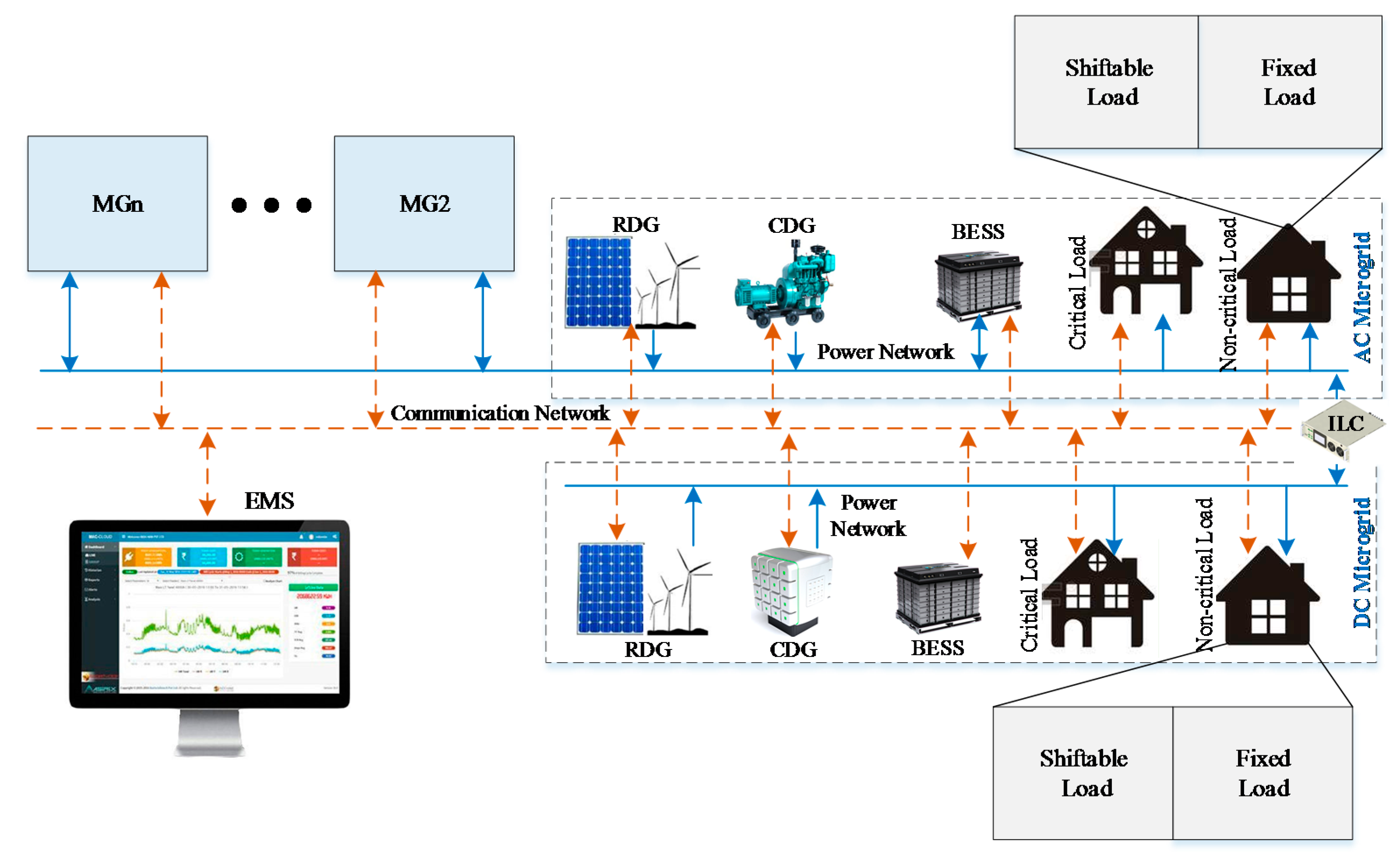
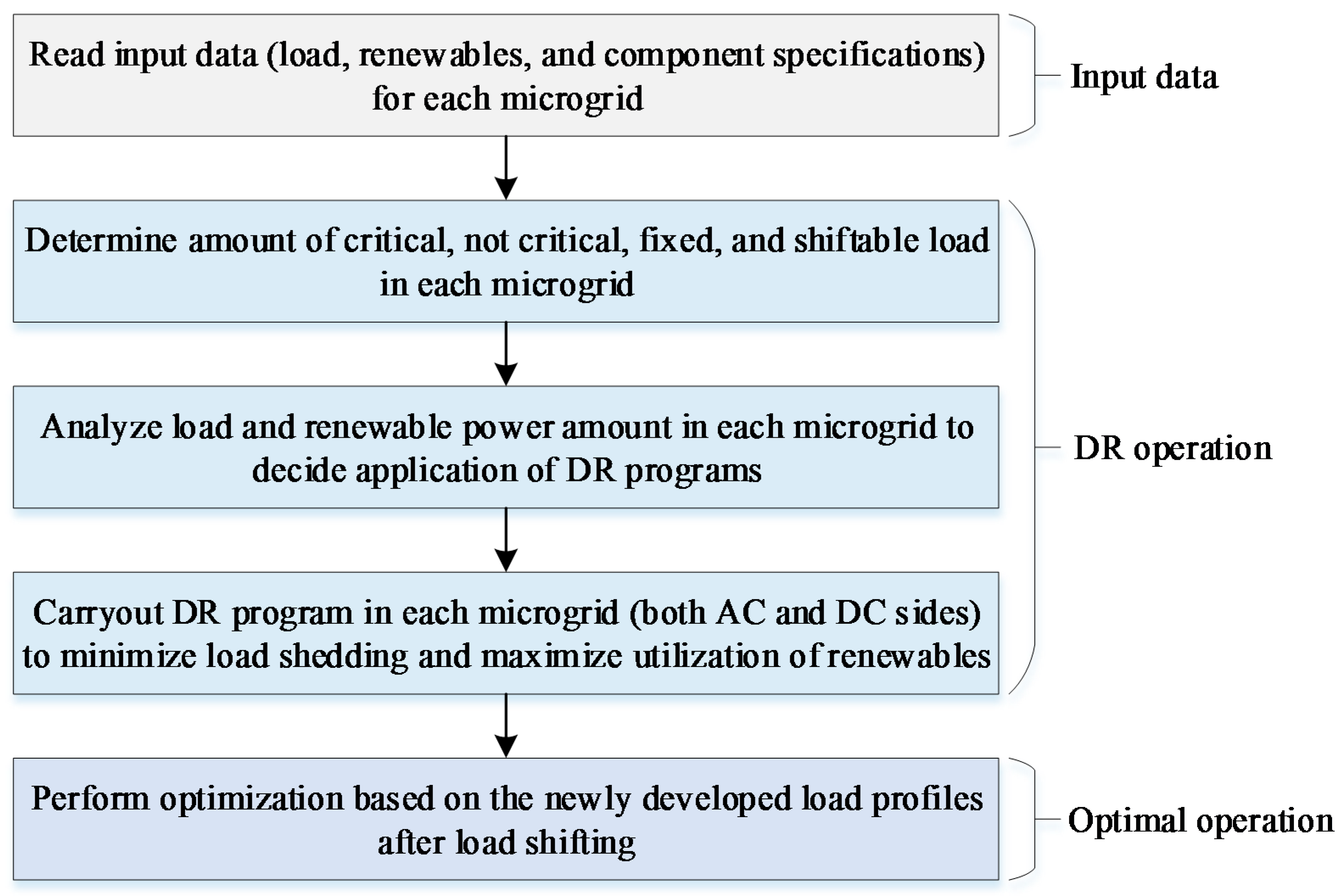
















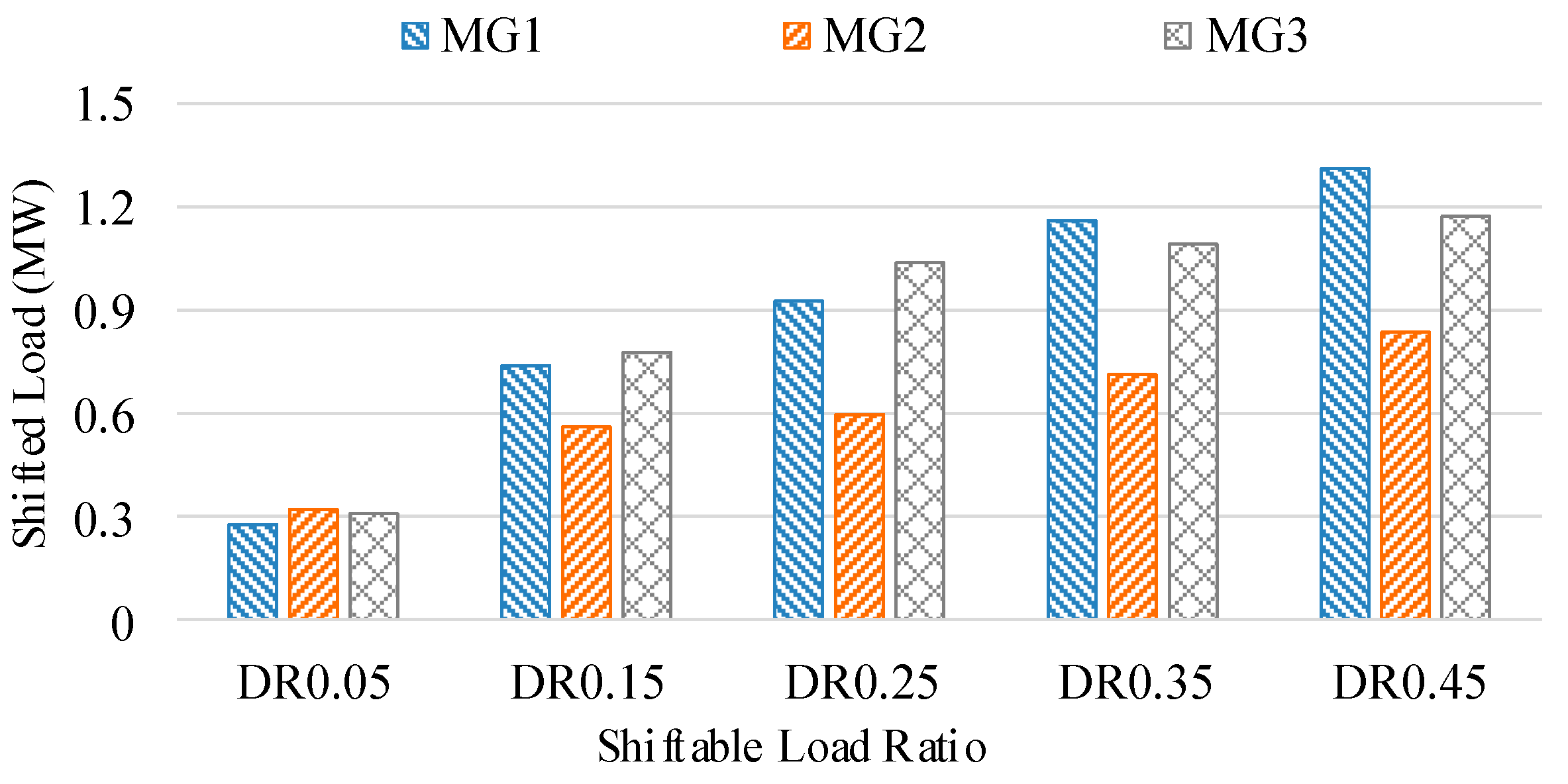


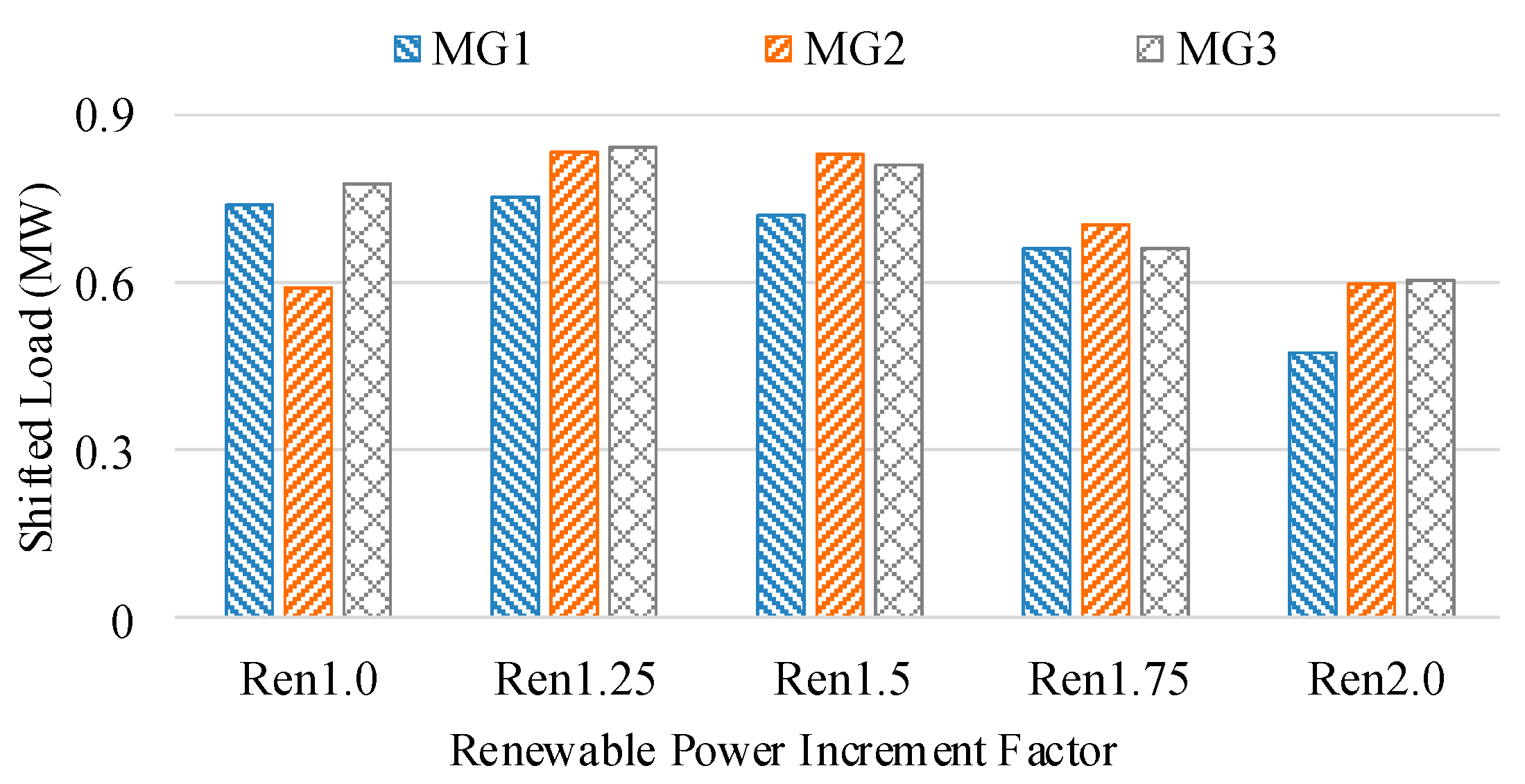


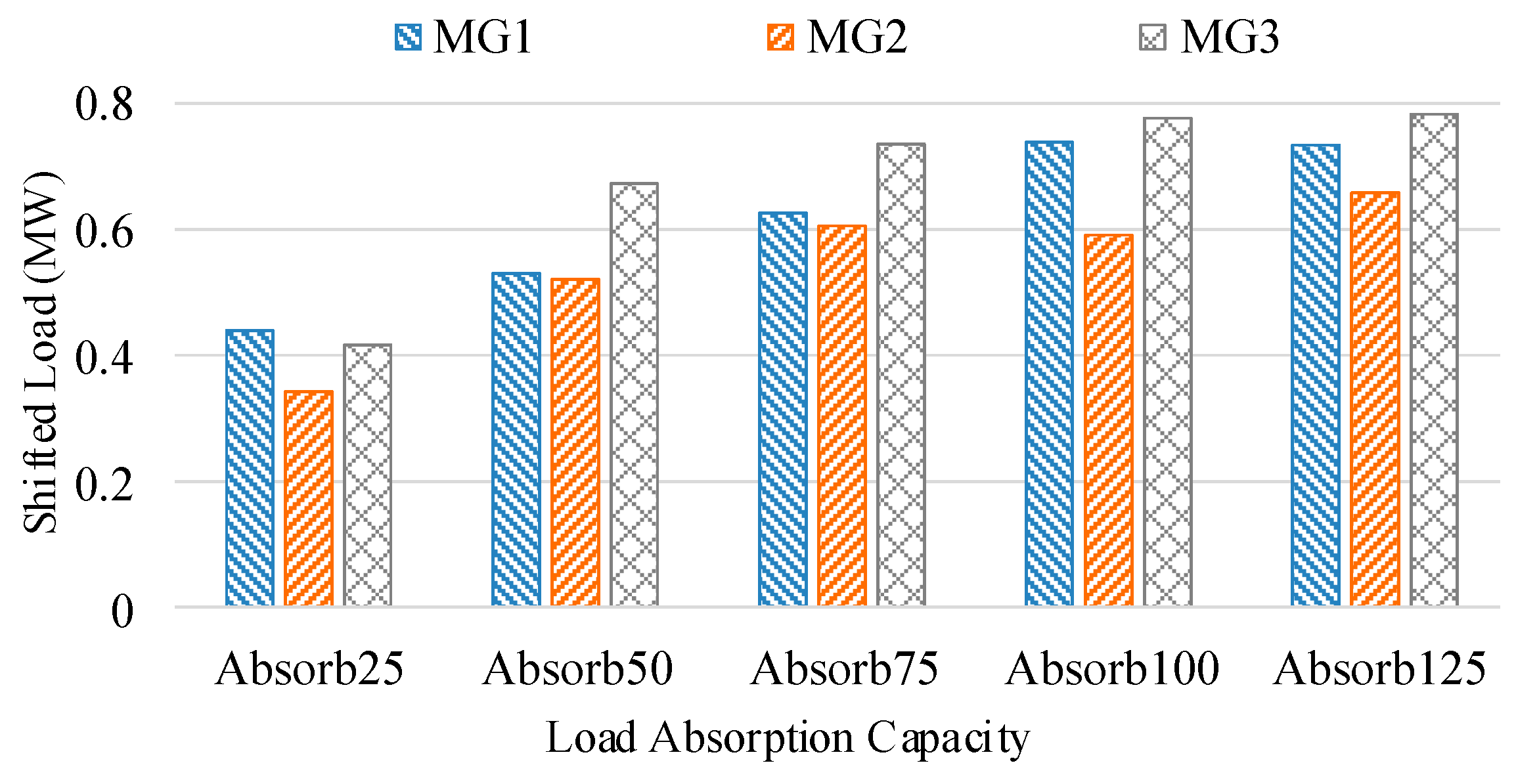
| Parameter | Unit | Microgrid 1 | Microgrid 2 | Microgrid 3 | |||
|---|---|---|---|---|---|---|---|
| AC CDG | DC CDG | AC CDG | DC CDG | AC CDG | DC CDG | ||
| Maximum | kW | 55 | 50 | 55 | 50 | 50 | 40 |
| Minimum | kW | 0 | 0 | 0 | 0 | 0 | 0 |
| Generation Cost | KRW/kWh | 100 | 106 | 116 | 103 | 104 | 108 |
| Parameter | Unit | Microgrid 1 | Microgrid 2 | Microgrid 3 | ||||
|---|---|---|---|---|---|---|---|---|
| AC Side | DC Side | AC Side | DC Side | AC Side | DC Side | |||
| BESS | Capacity | kWh | - | 50 | 50 | - | 50 | 50 |
| Efficiency | % | - | 98 | 97 | - | 97 | 98 | |
| Converter | Efficiency | % | - | 98 | 98 | - | 98 | 98 |
© 2019 by the authors. Licensee MDPI, Basel, Switzerland. This article is an open access article distributed under the terms and conditions of the Creative Commons Attribution (CC BY) license (http://creativecommons.org/licenses/by/4.0/).
Share and Cite
Park, S.-H.; Hussain, A.; Kim, H.-M. Impact Analysis of Survivability-Oriented Demand Response on Islanded Operation of Networked Microgrids with High Penetration of Renewables. Energies 2019, 12, 452. https://doi.org/10.3390/en12030452
Park S-H, Hussain A, Kim H-M. Impact Analysis of Survivability-Oriented Demand Response on Islanded Operation of Networked Microgrids with High Penetration of Renewables. Energies. 2019; 12(3):452. https://doi.org/10.3390/en12030452
Chicago/Turabian StylePark, Sung-Ho, Akhtar Hussain, and Hak-Man Kim. 2019. "Impact Analysis of Survivability-Oriented Demand Response on Islanded Operation of Networked Microgrids with High Penetration of Renewables" Energies 12, no. 3: 452. https://doi.org/10.3390/en12030452
APA StylePark, S.-H., Hussain, A., & Kim, H.-M. (2019). Impact Analysis of Survivability-Oriented Demand Response on Islanded Operation of Networked Microgrids with High Penetration of Renewables. Energies, 12(3), 452. https://doi.org/10.3390/en12030452






